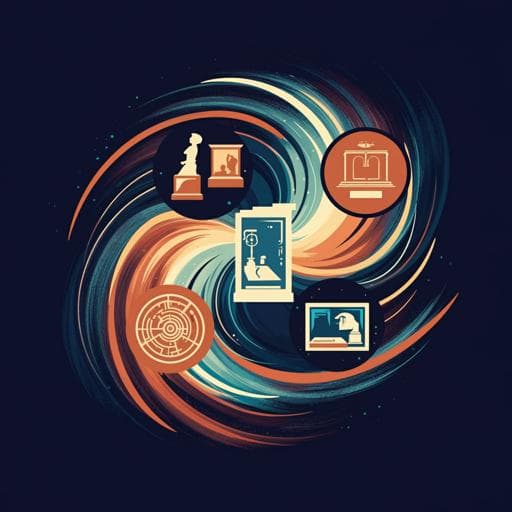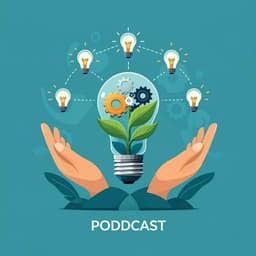
Education
Perceptions on the use of heritage to teach history in Secondary Education teachers in training
M. D. M. F. L. Fuente, Á. Chaparro-sainz, et al.
Explore how future secondary education teachers from three Spanish universities perceive heritage in teaching history. This research, conducted by María del Mar Felices-De la Fuente, Álvaro Chaparro-Sainz, and Raimundo A. Rodríguez-Pérez, reveals a strong appreciation for local history and technology, alongside the need for progressive, student-centered teaching methods.
~3 min • Beginner • English
Introduction
The study addresses how heritage education—conceived broadly to include tangible and intangible forms such as landscapes, scientific-technological and ethnological heritage—can contribute to meaningful history teaching and civic formation. It situates the problem in Spanish Secondary Education, where heritage is present only marginally and often subordinated to traditional, content-heavy, lecture-based instruction. The research question centers on future Secondary Education (Geography and History) teachers’ perceptions of using heritage to foster historical thinking and student engagement. The context underscores the societal importance of knowing, valuing, and safeguarding heritage, moving beyond economic or touristic framings, and the pedagogical need to connect students with nearby heritage through active methodologies, inquiry with primary sources, and educational outings.
Literature Review
The review highlights a longstanding concern with understanding students’ and teachers’ perceptions of history teaching, with special interest in teachers in training. Despite advances in research on history education, classroom practice in Secondary Education remains dominated by traditional lectures, textbook reliance, and summative assessment, leaving students passive. Active methodologies (projects, case studies, problem-based learning, school outings) are advocated to develop historical thinking and civic values. Heritage in curricula and textbooks is typically treated linearly and illustratively, emphasizing monumental, national-European narratives and neglecting local and intangible heritage. Future teachers value intangible heritage (e.g., music), yet lack skills to implement it and to transform ICT familiarity into learning and knowledge technologies (LKT). Emerging tools (augmented/virtual reality) are rarely experienced by them as students, limiting their didactic envisioning.
Methodology
Design: Basic research with a mixed-methods approach (simultaneous triangulation). Quantitative component: non-experimental survey using a Likert-scale questionnaire; qualitative component: open-ended questionnaire analyzed inductively.
Objectives: (a) Identify which heritage resources future teachers most value for teaching history; (b) analyze their assessment of heritage types as resources for teaching history and developing historical skills; (c) investigate their memories/experiences of heritage use during their own schooling.
Participants: Convenience (non-probabilistic, intentional) sample of 112 teachers in initial training (Master’s in Teacher Training for Secondary Education, Social Sciences specialization) from three Spanish universities (Malaga n=37; Almeria n=35; Murcia n=40). Sex: 58.93% men (66), 41.07% women (46). Age: 65.18% aged 20–25; 21.43% aged 26–30; 11.61% >30; average age men 26.16, women 25.71; Malaga men averaged 29.30. Prior degrees: History 54.46% (61), History of Art 21.43% (24), Geography 9.82%, Philosophy 6.25%, others 8.04%. About 14% had taken courses in educational innovation (active methodologies, educational technology, or other resources). Qualitative responses were provided by 110 participants (36 UMA, 35 UAL, 39 UMU).
Instruments: Quantitative questionnaire "Questionnaire on approaches to the teaching of history" with two parts: participant data and 78 items across blocks. This study analyzed five items from the materials/resources section focusing on heritage use: item 56 (museums and other heritage interpretation venues), 61 (local/regional festivities and traditions), 62 (virtual recreations of museums/centers), 63 (apps for mobiles/tablets with historical/heritage content), 65 (nearby historical/cultural heritage). Responses on a 1–5 scale. Reliability: ordinal Cronbach’s alpha = 0.74 for the set of items analyzed. Software: XLSTAT 2020.1.3 for quantitative analysis.
Qualitative instrument: Open questionnaire with 10 questions probing conceptions of heritage, didactic possibilities, benefits for historical competencies, heritage typologies to work with, learning from local/regional heritage, skills developed, suitability of foreign heritage, most appropriate heritage elements, heritage-related methodologies/resources to use, and remembered activities/methodologies experienced as students. Analysis with NVivo 12 using automatic coding (per question), free coding, and in vivo coding, yielding 58 codes; analyses included code matrices and clustering by word/code similarity.
Key Findings
Quantitative results (national sample context and three-university sample):
- Overall (national, 22 universities): Highest mean ratings among heritage-related resources were for item 65 Nearby historical/cultural heritage (Mean 4.61; Median 5; 67.10% rated 5), and item 56 Museums/interpretation venues (Mean 4.49; 57.20% rated 5). Item 62 Virtual recreations (Mean 4.12). Lower ratings for item 61 Festivities/traditions (Mean 3.86) and item 63 Mobile apps (Mean 3.65).
- In the three universities (UMA, UAL, UMU): Nearby heritage (item 65) was highest (combined mean ≈4.73; UMA 4.73, UAL 4.74, UMU 4.72). Museums (item 56) also highly rated (combined mean ≈4.61; UMA 4.65, UAL 4.66, UMU 4.53). Virtual recreations (item 62) rated higher than national overall (combined mean ≈4.31; UAL 4.49, UMA 4.38, UMU 4.08). Festivities/traditions (item 61) averaged 4.05 (UMA 4.14, UAL 4.14, UMU 3.88). Mobile apps (item 63) lowest (combined mean ≈3.91; UMA 4.05, UAL 3.97, UMU 3.73). Andalusian universities (UMA, UAL) tended to rate items higher than UMU.
- Reliability: Ordinal alpha = 0.74 for the resources linked to equity subset, considered acceptable.
Qualitative results (n=110):
- Most recurrent codes as perceived key teaching resources: Intangible heritage (104 mentions), Local heritage (83), Artistic heritage (81), Monuments (76), Museums (71), Audiovisual media/resources (57), Historical sources (51). Specific mentions within intangible heritage favored music (43) over festivities (18).
- When asked which other types of heritage they would work on (Q4), respondents emphasized Intangible heritage (65 mentions) more than Artistic (31) or Documentary (23); Musical heritage noted separately (27).
- Word/code similarity clustering (Pearson correlations) showed strong links: Local history–History teaching (r=0.881), Didactic visits–Didactic strategies (0.835), Didactic resources–Cultural heritage (0.834), Didactic resources–Intangible heritage (0.819), Didactic resources–Local heritage (0.789), Local heritage–History teaching (0.772), Didactic visits–Museum (0.763). ICT–Didactic strategies correlation was lower (0.633), aligning with lower app ratings.
- ICT: 52 participants (47.27%) referenced using ICT; only 4 explicit mentions of mobile apps; very few mentions of virtual/monumental recreations.
- Methodologies preferred (Q9 coding counts): Didactic outings (52), ICT (48), Debates (11), Flipped classroom (9), Group work (9), Gamification (8), Dramatization (6), Research/inquiry (6), Lectures (4). Didactic visits garnered 175 mentions across responses; 88.8% of respondents mentioned them, with UMU 92%.
- Historical documentary sources considered important (51 mentions); one in three students explicitly referenced their use.
Synthesis: Students most value nearby/local heritage and museums for teaching history; they recognize the potential of virtual recreations more than mobile apps; intangible heritage is conceptually valued in open responses (especially music) but specific elements like festivities are less favored; there is enthusiasm for didactic outings and some technology use, yet limited specificity and lower confidence regarding digital tools.
Discussion
Andalusian universities’ consistently higher ratings than Murcia’s may be influenced by a stronger curricular presence of heritage in Andalusia, as suggested by prior studies, warranting future comparative research. The prioritization of local heritage likely reflects its pedagogical affordances (contextualizing content in meaningful, emotive, identity-related ways) and students’ prior school experiences (museum/monument visits) shaping their expectations and professional identities. The relatively low valuation of mobile apps and new technologies contrasts with generally positive attitudes toward ICT in teacher education and appears linked to insecurity from insufficient specific training and digital pedagogical competence. Open-ended responses reveal recognition of ICT’s potential but lack specificity about tools (e.g., few mentions of mobile apps, VR/AR), suggesting a need for targeted training to convert ICT into genuine methodological innovation. A tension emerges around intangible heritage: despite frequent qualitative mentions, the specific item on festivities/traditions is rated comparatively low, indicating difficulties defining and integrating intangible heritage comprehensively in classroom practice. Strong associations between guided visits and history teaching, and between local heritage and didactic resources, underscore the perceived centrality of experiential, place-based learning. The importance attributed to historical sources aligns with frameworks for developing historical thinking, reinforcing the role of source work within heritage-based history education.
Conclusion
The study shows that future Secondary Education teachers perceive heritage—especially local/nearby heritage and museums—as fundamental resources for teaching history and developing historical thinking, alongside the use of historical documentary sources. Intangible heritage is valued conceptually, yet respondents exhibit gaps in accurately identifying its forms and in translating it into classroom practices; festivities/traditions are less favored than elements like music. While trainees acknowledge the necessity of integrating digital and virtual tools, they display limited specificity and lower valuation of mobile apps, revealing a skills/confidence gap. Memories of schooling are dominated by guided museum/heritage visits, which they intend to maintain but complement with other resources and strategies. The findings point to the need to enhance initial teacher education with practice-based experiences inside and outside the classroom, and to strengthen digital competence and specific training in heritage-related technologies (e.g., apps, VR/AR) so that ICT catalyzes real methodological change. Future research could examine how regional curricular emphases on heritage influence trainees’ perceptions and practices and evaluate the impact of targeted training interventions on integrating tangible and intangible heritage and digital tools into history teaching.
Limitations
- Sampling was non-probabilistic (convenience/intentional) and limited to three Spanish universities, which may constrain generalizability.
- The quantitative analysis focused on five heritage-related items from a broader instrument, potentially narrowing the scope of inferences about resources.
- The qualitative sample had two fewer respondents (n=110) than the quantitative (n=112).
- Participants reported limited prior training in educational innovation and digital tools, which may have influenced their appraisals of ICT-related items.
- Reliability for the analyzed items was acceptable but modest (ordinal alpha = 0.74).
Related Publications
Explore these studies to deepen your understanding of the subject.







